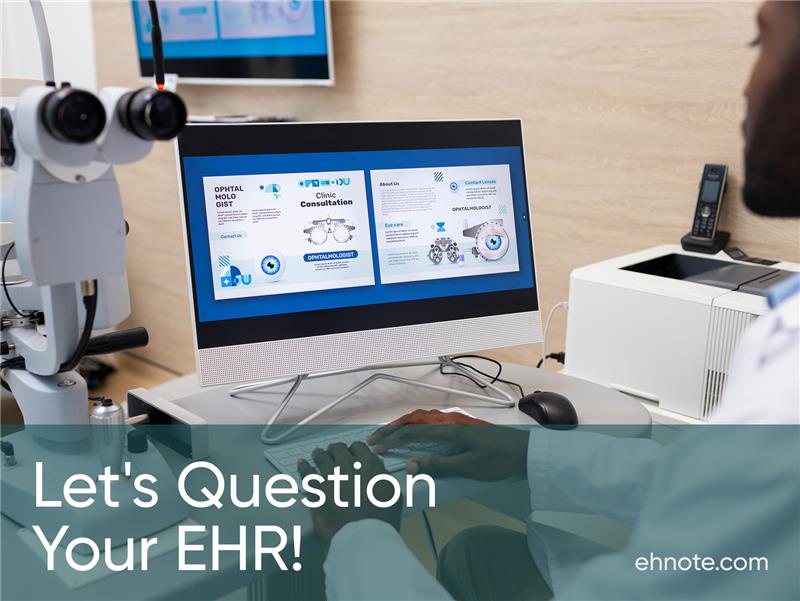How the Right Ophthalmology EHR Can Transform Your Practice in 2025 and Beyond

As an ophthalmologist, you’ve seen firsthand how technology shapes patient care. Yet, when it comes to your Electronic Health Record (EHR) system, have you ever stopped to ask: Is my EHR truly serving my team and patients, or is it adding unnecessary friction?
With so many options—from generic, one-size-fits-all platforms to specialized ophthalmology EMR software—it's time to question whether your system truly supports the fast-paced, data-driven world of modern eye care.
In today’s digital era, the tools you use every day can either streamline your workflows or create barriers that slow you down. With the increasing demands for efficiency, accuracy, and compliance (especially with HIPAA requirements), choosing the best ophthalmology EHR software is more crucial than ever.
This guide is here to help you evaluate your current system, understand emerging trends, and uncover how an integrated, ophthalmology-specific EHR can drive better patient outcomes, improved revenue, and enhanced practice management.
Why Every Ophthalmologist Should Re-examine Their EHR
The right ophthalmology EHR software should feel like a seamless extension of your workflow—not a hurdle. Yet, many practices struggle with:
-
Clunky user interfaces that require too many clicks and steal minutes from patient care.
-
Lack of customization limits ophthalmologistsfrom capturing the detailed nuances of eye care and forcing them to manually adjust.
-
Inefficient Integration with Diagnostic Tools leading to duplicate data entry and delays in accessing critical diagnostic information
-
Disjointed systems where EHRs, practice management tools, and billing software operate in silos.
-
Limited mobile accessibility for on-the-go care
-
Inflexible workflows that hinder surgical data management
-
Cumbersome reporting and analytics features
A 2023 MGMA report found that 62% of ophthalmologists cite EHR inefficiencies as a top contributor to staff burnout. The solution? Start asking tough questions.
5 Key Areas to Evaluate in Your Ophthalmology EHR
-
Is It Truly Built for Ophthalmology?
A best ophthalmology EHR software isn’t a one-size-fits-all product. It should offer:- Specialty-specific features
- Integrate with diagnostic tools
- Ophthalmology specific scheduling
- CPT/ICD-10 suggestions tailored to ophthalmic conditions
-
Does It Integrate with Practice Management and Billing?
Your ophthalmology EMR and billing software should work as a unified system. Look for:- Real-time eligibility checks during appointment scheduling
- Automated claim scrubbing to reduce denials
- Integrated, multi-juncture patient collections
- Financial dashboards tracking ASC revenue cycles or clinic AR days
-
How Intuitive Is the User Experience?
EHR software shouldn’t require a master’s in technology to navigate. Prioritize systems that:- Minimize clicks with auto-populated suggestions or voice-to-text dictation inputs.
- Offer customizable workflows for subspecialties
- Sync across devices so you can review post-op notes on a tablet or mobile device.
-
Is Compliance Baked into the System?
Electronic health records systems must safeguard sensitive data. Ensure your EHR:- Auto-locks screens after inactivity and enforces role-based access (e.g., technicians can’t edit surgical notes).
- Generates audit reports for HIPAA compliance
- Updates automatically with regulatory changes
-
What Support and Training Are Included?
Even the best electronic medical records software (emr) fails without proper onboarding. Evaluate:- In-person training
- 24/7 technical support with 2-hour response times for critical issues.
6 Red Flags It’s Time to Switch Your EHR
- Your staff dreads documentation and spends hours on corrections
- Coding errors lead to frequent claim denials
- Patient wait times creep up because charting lags behind.
- Your EHR can’t handle ASC workflows
- Compliance worries keep you up at night due to outdated security protocols
- Your vendor ignores feedback and your needs
Understanding the Core of Ophthalmology EHR Software
Specialization Matters
Generic EHR systems often fall short when it comes to the specialized needs of ophthalmology practices. Ophthalmology-specific EHR software is designed with your needs in mind.
It offers customizable templates that cater to a range of subspecialties—from retina to cornea, glaucoma to pediatric ophthalmology—ensuring that every detail is captured accurately. When you have an EHR tailored to your specialty, it’s like having a tool designed just for you, one that understands the nuances of eye care and helps you document patient encounters effortlessly.
Seamless Integration
A key challenge many practices face is the fragmentation of systems. Imagine trying to manage patient scheduling, billing, ASC charting, and clinical documentation across separate platforms—inefficiencies abound, and critical information can easily slip through the cracks.
An integrated Ophthalmology EHR combines all these elements into one cohesive system. Whether it’s synchronizing data from diagnostic imaging devices, streamlining ASC workflows, or automating billing and coding, integrated EHR systems allow you to focus on what matters most: providing exceptional patient care.
Compliance and Security
As regulatory compliance guidelines tighten day-by-day, compliance isn’t optional. HIPAA-compliant EHR software is a must, ensuring that all patient data is secure and accessible only to authorized users. The best ophthalmology EHR systems also align with ONC and CMS guidelines, which not only protects your practice from penalties but also builds trust with your patients by safeguarding their personal health information.
Dedicated Support
A top-notch ophthalmology EHR isn’t complete without robust vendor support. Ophthalmologists need a partner who listens to their feedback, offers timely updates, and provides ongoing technical assistance.
Reliable support ensures that any issues are quickly resolved, system enhancements are prioritized, and your software evolves with your practice’s unique needs. With dedicated support, you can focus on patient care rather than troubleshooting, knowing that expert help is always just a call or click away.
How to Transition Without Disrupting Your Practice
Switching EHRs is daunting, but a structured approach minimizes chaos:
-
Audit Pain Points
- Survey staff: What frustrates you most about our current EHR?
- Review metrics: Time per patient, coding accuracy rates, denial rates.
-
Demo Specialty-Specific Solutions
- Test how ophthalmology-specific EHRs handle complex scenarios.
-
Migration Previous Data
- Ensure historical records transfer securely.
-
Train Gradually
- Phase in modules to avoid overwhelm.
-
Measure Post-Switch Outcomes
- Track improvements in patient volume, claim acceptance rates, and staff satisfaction.
The Future of Ophthalmology EHRs: What’s Next?
Emerging trends are reshaping electronic health records software:
Artificial Intelligence (AI) at Work
AI is no longer a futuristic concept; it’s a reality transforming how healthcare is delivered. In ophthalmology, AI can help analyze diagnostic images, predict disease progression, and even assist in charting patient interactions through advanced speech-to-text capabilities.
Imagine an AI that listens as you discuss a patient’s symptoms and automatically populates the relevant sections of the electronic medical record. This isn’t just about saving time—it’s about ensuring accuracy, reducing errors, and ultimately improving patient outcomes.
Predictive Analytics for Proactive Care
Predictive analytics uses historical data to forecast trends and identify potential issues before they escalate. In a busy ophthalmology practice, this means the ability to spot at-risk patients early, schedule timely follow-ups, and adjust treatment plans based on real-time insights. Such capabilities can lead to a significant reduction in patient attrition and a boost in overall revenue, as proactive care tends to improve both clinical outcomes and patient satisfaction.
Interoperability and Cloud-Based Solutions
Interoperability—the seamless exchange of data between different systems—is a game changer for small practices. Modern Ophthalmology EHR software now comes equipped with FHIR-based APIs, allowing for smooth integration with diagnostic devices, ASC systems, and even third-party applications.
Cloud-based solutions further enhance this by ensuring that your data is accessible anywhere, anytime, without compromising on security. This means faster updates, easier collaboration among staff, and a more agile response to patient needs.
The Financial Impact: More Than Just Numbers
For eye practices, every minute and every dollar matters. By streamlining workflows and reducing manual errors, an integrated Ophthalmology EHR can have a direct and measurable impact on your bottom line. Consider these potential benefits:
- Time Savings: Automation of administrative tasks can free up significant time, allowing your staff to focus on patient care rather than repetitive data entry.
- Increased Revenue: Improved billing accuracy and faster claim processing reduce denials and delays, leading to a healthier cash flow.
- Enhanced Patient Retention: Smoother, more efficient patient interactions foster loyalty, leading to higher patient retention rates and a steady revenue stream.
These quantifiable benefits illustrate that investing in the right EHR software isn’t just a tech upgrade—it’s a strategic move that can transform the financial and operational health of your practice.
Final Thought: Your EHR Should Empower, Not Hinder
An EHR isn’t just a regulatory checkbox—it’s a strategic asset. By choosing an ophthalmology electronic medical record (emr) software designed for your specialty, you protect your team’s bandwidth, safeguard revenue, and free up time for what matters: delivering exceptional eye care.
Ready to explore modern solutions?Discover how purpose-built EHRs streamline ophthalmology workflows
Explore how EHNOTE’s cutting-edge solutions can help you stay ahead in a competitive market.
